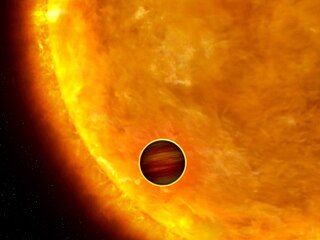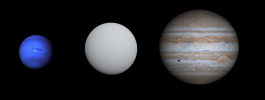Related Research Articles

CoRoT was a space telescope mission which operated from 2006 to 2013. The mission's two objectives were to search for extrasolar planets with short orbital periods, particularly those of large terrestrial size, and to perform asteroseismology by measuring solar-like oscillations in stars. The mission was led by the French Space Agency (CNES) in conjunction with the European Space Agency (ESA) and other international partners.

CoRoT-1b is a transiting extrasolar planet approximately 2,630 light-years away in the constellation of Monoceros. The planet was discovered orbiting the yellow dwarf star CoRoT-1 in May 2007. The planet was the first discovery by the French-led CoRoT Mission.

CoRoT-2b is the second extrasolar planet to be detected by the French-led CoRoT mission, and orbits the star CoRoT-2 at a distance of 700 light years from Earth towards the constellation Aquila. Its discovery was announced on 20 December 2007. After its discovery via the transit method, its mass was confirmed via the radial velocity method.

CoRoT-5b is an extrasolar planet orbiting the F type star CoRoT-5. It was first reported by the CoRoT mission team in 2008 using a transit method. This planet has been confirmed by a Doppler follow-up study.

CoRoT-7b is an exoplanet orbiting the star CoRoT-7 in the constellation of Monoceros, 489 light-years from Earth. It was first detected photometrically by the French-led CoRoT mission and reported in February 2009. Until the announcement of Kepler-10b in January 2011, it was the smallest exoplanet to have its diameter measured, at 1.58 times that of the Earth and the first potential extrasolar terrestrial planet to be found. The exoplanet has a very short orbital period, revolving around its host star in about 20 hours.

CoRoT-1 is a yellow dwarf main sequence star similar to the Sun. The star is located approximately 2,630 light-years away in the constellation of Monoceros. The apparent magnitude of this star is 13.6, which means it is not visible to the naked eye; however, it can be seen through a medium-sized amateur telescope on a clear, dark night. The first exoplanet discovered in the course of the CoRoT mission orbits this star; it is considered to be a "hot Jupiter", and is approximately as massive as the planet Jupiter itself.
CoRoT-2 is a yellow dwarf main sequence star a little cooler than the Sun. This star is located approximately 700 light-years away in the constellation of Aquila. The apparent magnitude of this star is 12, which means it is not visible to the naked eye but can be seen with a medium-sized amateur telescope on a clear dark night.
CoRoT-7 is a binary star system. The primary, CoRoT-7A is a G-type main sequence star, slightly smaller, cooler, and younger than the Sun. It has an apparent magnitude of 11.67, fainter than Proxima Centauri, the nearest star to the Sun. This star is approximately 520 light-years away from the Solar System in the constellation Monoceros.
CoRoT-21b is a transiting exoplanet reportedly found by the CoRoT space telescope in 2011. Planetary parameters were published in 2012.

CoRoT-8b is a transiting exoplanet orbiting the K-type main sequence star CoRoT-8 1,050 light years away in the equatorial constellation Aquila. The planet was discovered in April 2010 by the CoRoT telescope.
CoRoT-10b is a transiting Hot Jupiter exoplanet found by the CoRoT space telescope in 2010.
CoRoT-11b is a transiting Hot Jupiter-sized exoplanet found by the CoRoT space telescope in 2010.
CoRoT-12b is a transiting Hot Jupiter-sized exoplanet found by the CoRoT space telescope in 2010.
CoRoT-14b is a transiting Hot Jupiter exoplanet found by the CoRoT space telescope in 2010.
CoRoT-18b is a transiting Hot Jupiter exoplanet found by the CoRoT space telescope in 2011.
CoRoT-19b is a transiting exoplanet found by the CoRoT space telescope in 2011.
CoRoT-20b is a transiting exoplanet found by the CoRoT space telescope in 2011.
CoRoT-22b is a transiting exoplanet smaller then Uranus found by the CoRoT space telescope in 2011 and confirmed in 2014.
CoRoT-23b is a transiting Hot Jupiter exoplanet found by the CoRoT space telescope in 2011.
References
- ↑ "Notes on CoRoT-17 b" . Retrieved February 25, 2019.
- 1 2 Csizmadia, Sz.; et al. (2011), "Transiting exoplanets from the CoRoT space mission", Astronomy & Astrophysics, 531: A41, arXiv: 1106.4393 , doi:10.1051/0004-6361/201117009, S2CID 54618864
- ↑ "COROT-17 Planets in the system" . Retrieved February 25, 2019.
- ↑ "NEW WORLDS ATLAS CoRoT-17 b" . Retrieved February 25, 2019.